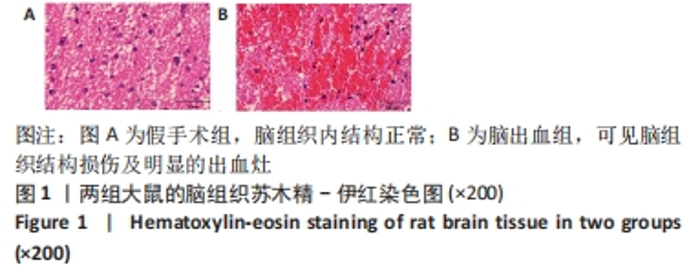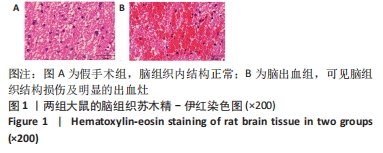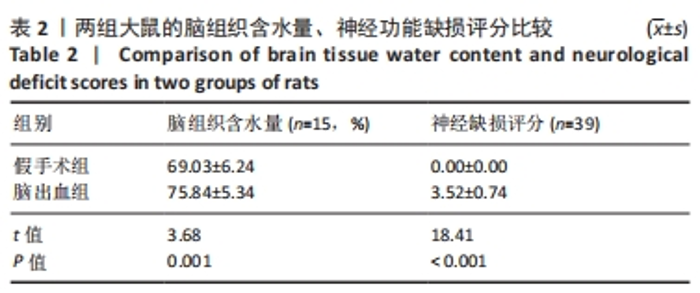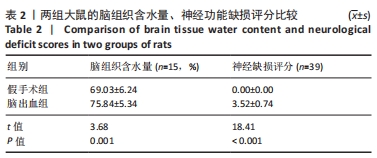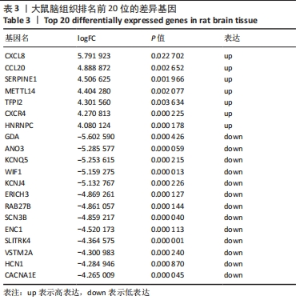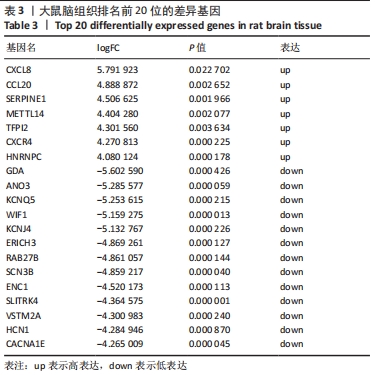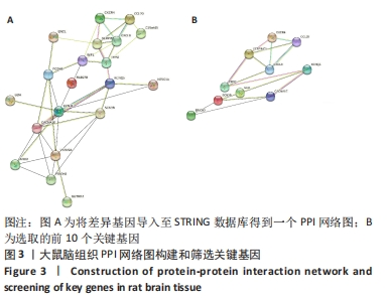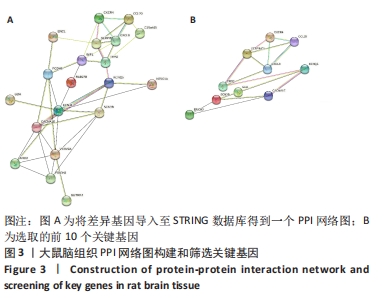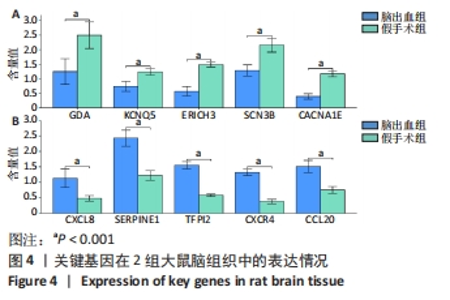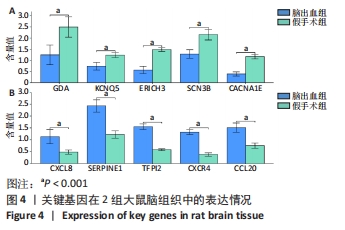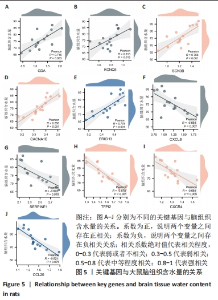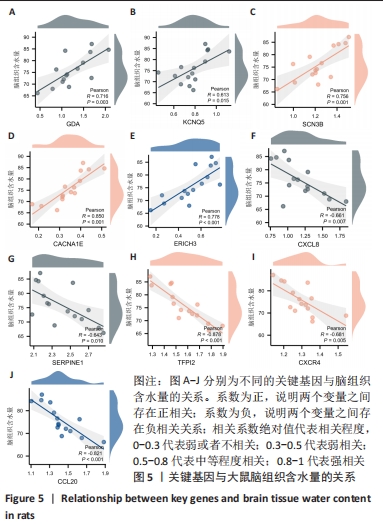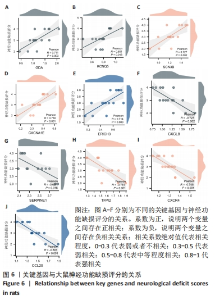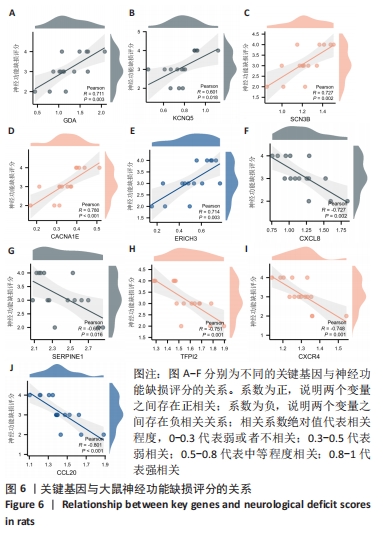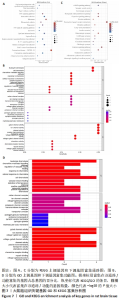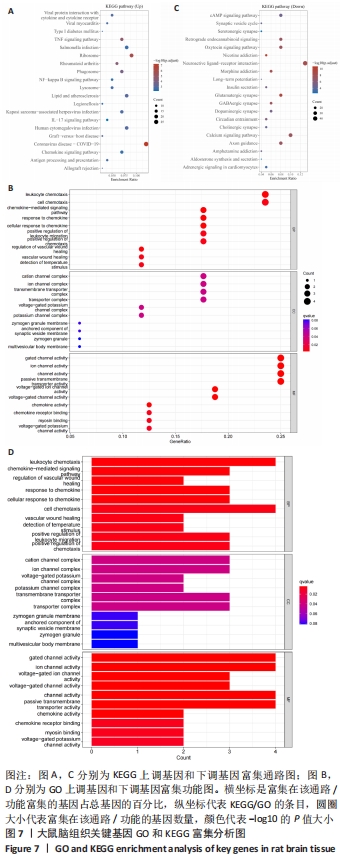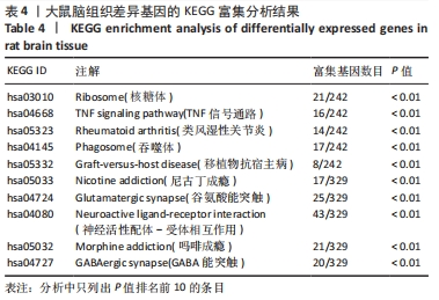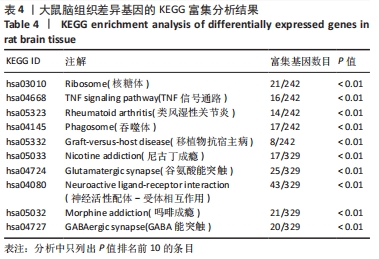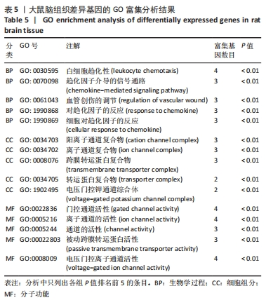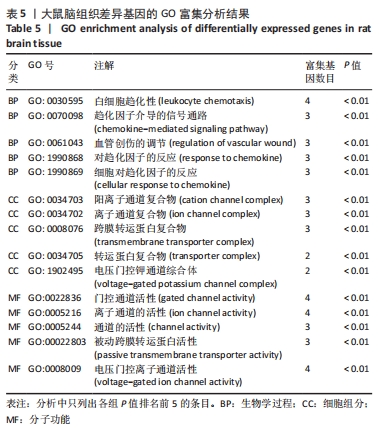Chinese Journal of Tissue Engineering Research ›› 2024, Vol. 28 ›› Issue (20): 3182-3189.doi: 10.12307/2024.354
Previous Articles Next Articles
Sequencing, verification and functional analysis of differentially expressed genes in brain tissue of a rat model with acute intracerebral hemorrhage
Gao Yuguang, Zhong Jie, Huang Deqing, Ma Yujuan, Liao Yuxiong, Liu Qiqi
- The First Affiliated Hospital of Guangxi University of Chinese Medicine, Nanning 530023, Guangxi Zhuang Autonomous Region, China
-
Received:2023-05-10Accepted:2023-06-07Online:2024-07-18Published:2023-09-09 -
Contact:Zhong Jie, Master, Associate chief physician, The First Affiliated Hospital of Guangxi University of Chinese Medicine, Nanning 530023, Guangxi Zhuang Autonomous Region, China -
About author:Gao Yuguang, Master, Attending physician, The First Affiliated Hospital of Guangxi University of Chinese Medicine, Nanning 530023, Guangxi Zhuang Autonomous Region, China -
Supported by:Guangxi Education Department Project for Improving the Scientific Research Basic Ability of Young and Middle-aged Teachers in Universities, No. 2020KY07015 (to GYG); Self-financed Scientific Research Project of Guangxi Zhuang Autonomous Region Health Commission, No. 20210943 (to GYG); Guangxi Traditional Chinese Medicine Key Discipline Construction Project, No. GZXK-Z-20-47; Guangxi Medical and Health Key Cultivation Discipline Construction Project, No. [2021]8
CLC Number:
Cite this article
Gao Yuguang, Zhong Jie, Huang Deqing, Ma Yujuan, Liao Yuxiong, Liu Qiqi. Sequencing, verification and functional analysis of differentially expressed genes in brain tissue of a rat model with acute intracerebral hemorrhage[J]. Chinese Journal of Tissue Engineering Research, 2024, 28(20): 3182-3189.
share this article
Add to citation manager EndNote|Reference Manager|ProCite|BibTeX|RefWorks
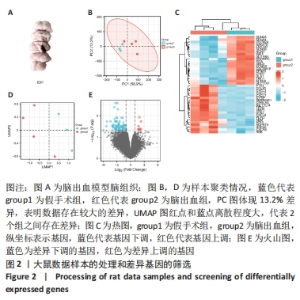
2.3 差异基因筛选结果 见图2。脑出血组大鼠的脑组织可见明显出血灶(图2A)。PCA图(图2B)和UMAP图(图2D)表示脑出血组和假手术组的样本分开,两组之间差异明显,后续的差异基因分析有意义。以log2FC的绝对值> 1和校正P < 0.05为标准分析,经过分析,总共筛选出81个差异基因,其中包含8个表达上调基因和73个表达下调基因,将该数据集差异基因进行可视化(图2C,E);同时根据logFC数值大小筛选出排名最靠前的20个的差异基因:CXCL8、CCL20、SERPINE1、METTL14、TFPI2、CXCR4、HCN1、GDA、ANO3、KCNQ5、WIF1、KCNJ4、ERICH3、RAB27B、SCN3B、ENC1、SLITRK4、VSTM2A、HNRNPC、CACNA1E,见表3。"
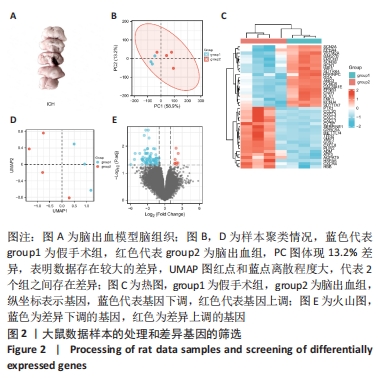

2.8.1 GO分析 生物过程(biological processes,BP):DEGs主要富集于白细胞趋化性(leukocyte chemotaxis)、趋化因子介导的信号通路(chemokine-mediated signaling pathway)、血管创伤的调节(regulation of vascular wound);细胞组成(cellular components,CC):DEGs主要富集于阳离子通道复合物(cation channel complex)、离子通道复合物(ion channel complex)、跨膜转运蛋白复合物(transmembrane transporter complex);分子功能(molecular functions,MF):DEGs主要富集于门控通道活动(gated channel activity)、离子通道的活动(ion channel activity)、通道的活性(channel activity)。 2.8.2 KEGG通路富集分析 DEGs集中于TNF信号通路(TNF signaling pathway),谷氨酸能突触(Glutamatergic synapse)、GABA能突触(GABAergic synapse)。"

| [1] PUY L, PARRY-JONES AR, SANDSET EC, et al. Intracerebral haemorrhage. Nat Rev Dis Primers. 2023;9(1):14. [2] COCHRANE A, CHEN C, STEPHEN J, et al. Antithrombotic treatment after stroke due to intracerebral haemorrhage. Cochrane Database Syst Rev. 2023;1(1):CD012144. [3] CHENG Z, ZHANG W, ZHAN Z, et al. Cerebral small vessel disease and prognosis in intracerebral haemorrhage: A systematic review and meta-analysis of cohort studies. Eur J Neurol. 2022;29(8):2511-2525. [4] DIANQUAN ZHANG, GUOLIANG CAI, KAI LIU, et al. Microglia exosomal miRNA-137 attenuates ischemic brain injury through targeting Notch1. Aging(Albany NY). 2021;13(3):4079-4095. [5] MOVAHED M, BROCKIE S, HONG J, et al. Transcriptomic Hallmarks of Ischemia-Reperfusion Injury. Cells. 2021;10(7):1838. [6] ROSELL A, VILALTA A, GARCÍA-BERROCOSO T, et al. Brain perihematoma genomic profile following spontaneous human intracerebral hemorrhage. PLoS One. 2011;6(2):e16750. [7] 万志刚.基于大鼠脑出血高通量测序的miRNA表达谱生物信息学分析[D].南昌:南昌大学,2018. [8] 李裕思,许华冲,王俊月,等.16S rRNA基因测序技术分析肝阳上亢型脑出血患者的肠道菌群结构[J].中国实验方剂学杂志,2019, 25(8):83-88 [9] 张萌.血液白细胞单细胞转录组测序解析高血压脑出血的发病机制[D].北京:北京协和医学院,2021. [10] TSIVGOULIS G, PATOUSI A, PIKILIDOU M, et al. Stroke Incidence and Outcomes in Northeastern Greece: The Evros Stroke Registry. Stroke. 2018;49(2):288-295. [11] 中华医学会神经病学分会.中国脑出血诊治指南(2019) [J].中华神经科杂志,2019,52(12):994-1006. [12] MAGID-BERNSTEIN J, GIRARD R, POLSTER S, et al.Cerebral Hemorrhage: Pathophysiology, Treatment, and Future Directions. Circ Res. 2022; 130(8):1204-1229. [13] PUY L, PERBET R, FIGEAC M, et al. Brain Peri-Hematomal Area, a Strategic Interface for Blood Clearance: A Human Neuropathological and Transcriptomic Study. Stroke. 2022;53(6):2026-2035. [14] LIU H, HUA Y, KEEP RF. Brain Ceruloplasmin Expression After Experimental Intracerebral Hemorrhage and Protection Against Iron-Induced Brain Injury. Transl Stroke Res. 2019;10(1):112-119. [15] HALCROW PW, LYNCH ML, GEIGER JD, et al. Role of endolysosome function in iron metabolism and brain carcinogenesis. Semin Cancer Biol. 2021;76:74-85. [16] LIU J, LI Q, REN J, et al. Association of Sex with Serum Potassium, Sodium, and Calcium Disorders after Hypertensive Intracerebral Hemorrhage. World Neurosurg. 2020;141:e367-e373. [17] KITAMURA M, TATEISHI Y, SATO S, et al. Association between serum calcium levels and prognosis, hematoma volume, and onset of cerebral hemorrhage in patients undergoing hemodialysis. BMC Nephrol. 2019;20(1):210. [18] LI L, QI C, LIU Y, et al. MicroRNA miR-27b-3p regulate microglial inflammation response and cell apoptosis by inhibiting A20 (TNF-α-induced protein 3). Bioengineered. 2021;12(2):9902-9913. [19] 龚浩,郑波,何俊,等.急性脑出血病人血清TNF-α、TGF-β1、ICAM-1水平与神经功能损伤及预后的相关性[J].中西医结合心脑血管病杂志,2021,19(13):2264-2267 [20] Leira R, Castellanos M, Alvarez-Sabín J, et al. Headache in cerebral hemorrhage is associated with inflammatory markers and higher residual cavity. Headache. 2005;45(9):1236-1243. [21] 宋春旺,田军,李国英,等.右美托咪定在危重高血压脑出血患者开颅术后的应用研究[J].河北医药,2020,42(21):3205-3208+3213 [22] ORDRONNEAU P, WOODLEY JC, GROSSMAN G, et al. Characterization of an antiserum to glycyl-d-aspartate (GDA) and its use as a probe for endogenous N-methyl-d-aspartate (NMDA)-like compounds. Mol Cell Neurosci. 1992;3(3):259-266. [23] LI X, CHEN F, JU J, et al. Long Non-Coding RNA-GDA-1 Promotes Keratinocyte Proliferation and Psoriasis Inflammation by Regulating the STAT3/NF-κB Signaling Pathway via Forkhead Box M1.Inflammation. 2023. doi: 10.1007/s10753-023-01800-x. [24] KRÜGER J, SCHUBERT J, KEGELE J, et al.Loss-of-function variants in the KCNQ5 gene are implicated in genetic generalized epilepsies. EBioMedicine. 2022;84:104244. [25] NAPPI M, BARRESE V, CAROTENUTO L, et al. Gain of function due to increased opening probability by two KCNQ5 pore variants causing developmental and epileptic encephalopathy. Proc Natl Acad Sci USA. 2022;119(15):e2116887119. [26] LIU D, ZHUANG Y, ZHANG L, et al. ERICH3:vesicular association and antidepressant treatment response. Mol Psychiatry. 2021;26(6):2415-2428. [27] HAN Y, CHEN L, LIU J, et al. A Class I HDAC Inhibitor Rescues Synaptic Damage and Neuron Loss in APP-Transfected Cells and APP/PS1 Mice through the GRIP1/AMPA Pathway. Molecules. 2022;27(13):4160. [28] DONG Y, CHEN Y, YAO B, et al. Neuropathologic damage induced by radiofrequency ablation at different temperatures. Clinics (Sao Paulo). 2022;77:100033. [29] WANG Y, TIAN Y, ZHAO J, et al. Effect of electroacupuncture on gene expression in calcium signaling pathway in hippocampal cells in mice with cerebral ischemia reperfusion. J Tradit Chin Med. 2017;37(2):252-260. [30] 郭廷旺, 郝石磊,王伯初.力学通道蛋白Piezos在脑出血后静水压传导过程中的作用[J].医用生物力学,2019,34(S1):174 [31] ZHANG J, ZHANG X, SHANG Y, et al. Effect of Cinepazide Maleate on Serum Inflammatory Factors of ICU Patients with Severe Cerebral Hemorrhage after Surgery. Evid Based Complement Alternat Med. 2021;2021:6562140. [32] ZHOU X, CHEN J, WANG C, et al. Anti-inflammatory effects of Simvastatin in patients with acute intracerebral hemorrhage in an intensive care unit. ExpTher Med. 2017;14(6):6193-6200. [33] ZHANG W, ZHAO W, GE C, et al. Scopoletin Attenuates Intracerebral Hemorrhage-Induced Brain Injury and Improves Neurological Performance in Rats.Neuroimmunomodulation. 2021;28(2):74-81. [34] KREMER V, BINK DI, STANICEK L, et al. MEG8 regulates Tissue Factor Pathway Inhibitor 2(TFPI2) expression in the endothelium. Sci Rep. 2022;12(1):843. [35] LUO L, ZANG G, LIU B, et al. Bioengineering CXCR4-overexpressing cell membrane functionalized ROS-responsive nanotherapeutics for targeting cerebral ischemia-reperfusion injury. Theranostics. 2021; 11(16):8043-8056. [36] PUN PB, LU J, MOOCHHALA S. Involvement of ROS in BBB dysfunction. Free Radic Res. 2009;43(4):348-364. |
| [1] | Chen Mengmeng, Bao Li, Chen Hao, Jia Pu, Feng Fei, Shi Guan, Tang Hai. Biomechanical characteristics of a novel interspinous distraction fusion device BacFuse for the repair of lumbar degenerative disease [J]. Chinese Journal of Tissue Engineering Research, 2024, 28(9): 1325-1329. |
| [2] | Weng Rui, Lin Dongxin, Guo Haiwei, Zhang Wensheng, Song Yuke, Lin Hongheng, Li Wenchao, Ye Linqiang. Abnormal types of intervertebral disc structure and related mechanical loading with biomechanical factors [J]. Chinese Journal of Tissue Engineering Research, 2024, 28(9): 1436-1442. |
| [3] | Yang Yufang, Yang Zhishan, Duan Mianmian, Liu Yiheng, Tang Zhenglong, Wang Yu. Application and prospects of erythropoietin in bone tissue engineering [J]. Chinese Journal of Tissue Engineering Research, 2024, 28(9): 1443-1449. |
| [4] | Bai Chen, Yang Wenqian, Meng Zhichao, Wang Yuze. Strategies for repairing injured anterior cruciate ligament and promoting graft healing [J]. Chinese Journal of Tissue Engineering Research, 2024, 28(9): 1457-1463. |
| [5] | Qi Xue, Li Jiahui, Zhu Yuanfeng, Yu Lu, Wang Peng. Abnormal modification of alpha-synuclein and its mechanism in Parkinson’s disease [J]. Chinese Journal of Tissue Engineering Research, 2024, 28(8): 1301-1306. |
| [6] | Liu Xin, Hu Man, Zhao Wenjie, Zhang Yu, Meng Bo, Yang Sheng, Peng Qing, Zhang Liang, Wang Jingcheng. Cadmium promotes senescence of annulus fibrosus cells via activation of PI3K/Akt signaling pathway [J]. Chinese Journal of Tissue Engineering Research, 2024, 28(8): 1217-1222. |
| [7] | Ruan Rong, Lou Xujia, Jin Qiguan, Zhang Libing, Xu Shang, Hu Yulong. Effect of resveratrol on gluconeogenesis in exercise-induced fatigue rats [J]. Chinese Journal of Tissue Engineering Research, 2024, 28(8): 1229-1234. |
| [8] | Kong Jianda, Mu Yujing, Zhu Lei, Li Zhilin, Chen Shijuan. Mechanism of satellite cell regulation and its role in ecological niche signaling during skeletal muscle regeneration [J]. Chinese Journal of Tissue Engineering Research, 2024, 28(7): 1105-1111. |
| [9] | Huang Yuxin, Liang Wenzi, Chen Xiuwen, Ni Na, Zhao Yinglin, Lin Changmin. Role of autophagy in hair regeneration [J]. Chinese Journal of Tissue Engineering Research, 2024, 28(7): 1112-1117. |
| [10] | Wang Wen, Zheng Pengpeng, Meng Haohao, Liu Hao, Yuan Changyong. Overexpression of Sema3A promotes osteogenic differentiation of dental pulp stem cells and MC3T3-E1 [J]. Chinese Journal of Tissue Engineering Research, 2024, 28(7): 993-999. |
| [11] | Kaiyisaier•Abudukelimu, Maimaitimin•Abulimiti, Li Lei, Yang Xiaokai, Zhang Yukun, Liu Shuai. Effect of lumbar CT values in the diagnosis of osteoporosis in women patients with lumbar degenerative diseases [J]. Chinese Journal of Tissue Engineering Research, 2024, 28(6): 945-949. |
| [12] | Zhang Kefan, Shi Hui. Research status and application prospect of cytokine therapy for osteoarthritis [J]. Chinese Journal of Tissue Engineering Research, 2024, 28(6): 961-967. |
| [13] | Zhang Zeyi, Yang Yimin, Li Wenyan, Zhang Meizhen. Effect of foot progression angle on lower extremity kinetics of knee osteoarthritis patients of different ages: a systematic review and meta-analysis [J]. Chinese Journal of Tissue Engineering Research, 2024, 28(6): 968-975. |
| [14] | Zhang Ya, Mu Qiuju, Wang Zilin, Liu Hongjie, Zhu Lili. Hydrogel loaded with platelet-rich plasma promotes wound healing in diabetic rats [J]. Chinese Journal of Tissue Engineering Research, 2024, 28(5): 690-696. |
| [15] | Zhu Liwei, Wang Jiangyue, Bai Ding. Application value of nanocomposite gelatin methacryloyl hydrogels in different bone defect environments [J]. Chinese Journal of Tissue Engineering Research, 2024, 28(5): 753-758. |
| Viewed | ||||||
|
Full text |
|
|||||
|
Abstract |
|
|||||
